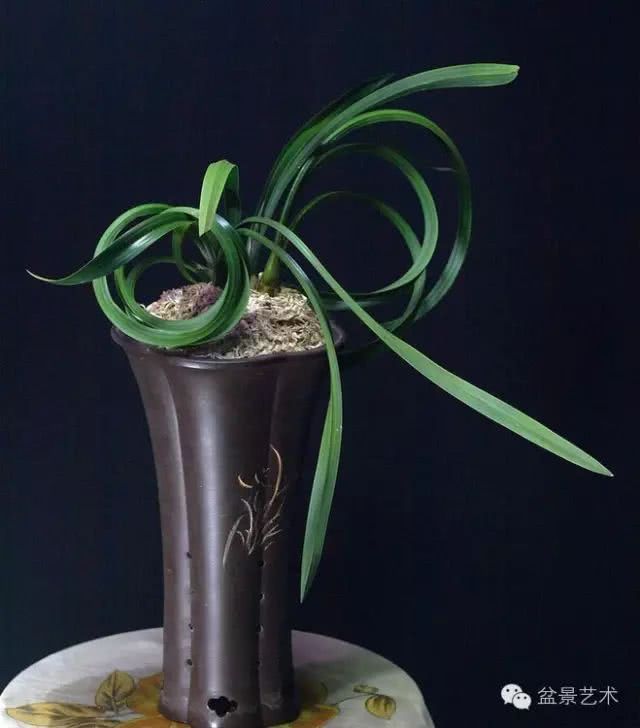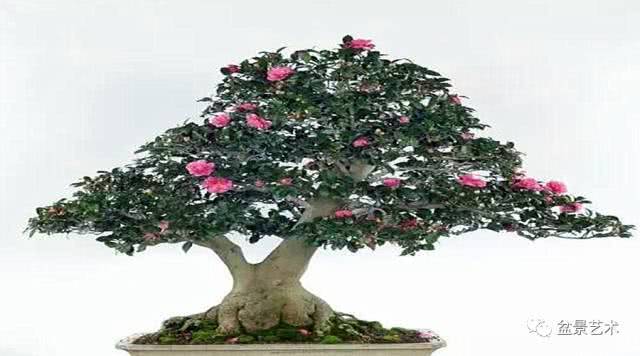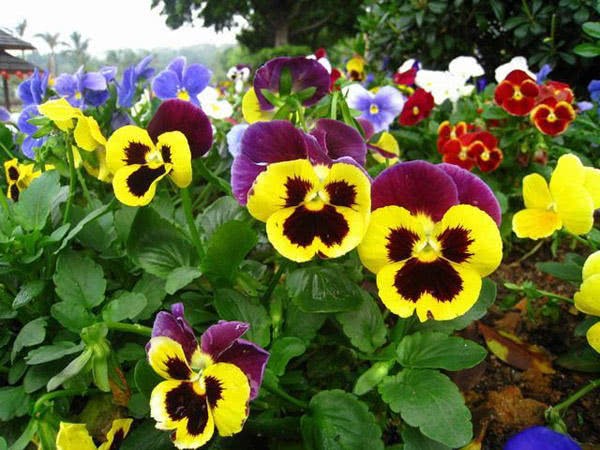Orchid production and maintenance

Orchid leaves elegant, graceful, many but not disorderly, its flowers fragrance Qingyuan, fragrant attack, a plant in the room, the room full of fragrance. Orchids, plums, bamboos and chrysanthemums are called "four gentlemen". Orchids born in the valley sparse stone leaves, silver roots wrong, leathery evergreen, do not compete with peaches and plums, do not change color because of frost and snow, elegant posture, fragrance overflowing, no wonder people call it "the first fragrance in the world", "national fragrance". The ancients Zhang Yu wrote a poem praising orchids: "if you can be white, you can be yellow, and no one can be fragrant from yourself." It can be seen from this poem that the ancients regarded the orchid as a gentleman and regarded it as a symbol of firmness, beauty and nobility.
1. Modeling layout
Making bonsai with orchids is often combined with mountains and rocks to imitate the layout method of "orchid stone map" in Chinese painting. Some plant several orchids of different heights at one end of the pot, place one or two tall and exquisitely carved rocks at the other end of the pot not far from the orchid, and adorn the basin with 2 or 3 graceful pebbles to set off. Some 4-5 orchids of different sizes and heights are planted in the pot, and several rocks of appropriate size and elegant shape are placed in the basin. In the production of blue stone bonsai, we should pay attention to the height of orchid and stone, if equal, no distinction between primary and secondary, the artistic conception will not be beautiful. To make orchid bonsai, you can use the most widely cultivated spring orchid in China. Cymbidium leaves narrow and long, generally 20-50 cm, scape erect, light yellowish green, fragrant, flowering from February to March. Bonsai made of spring orchids and rocks, the mountains and rocks are tall and straight, the orchid leaves are curved and soft, elegant and natural, pleasant aroma, full of poetic and picturesque.
2. Planting and using pots
Orchids that have just been bought from a florist or dug up from the mountains should be cultivated in earthen pots for 1-2 years to make plants adapt to the new environment. Only after they have grown healthily can they make bonsai in fine pots. Bonsai basins are rectangular, oval, round, long octagonal and fan-shaped. Commonly used medium-depth purple sand basin, such as the bowl is too deep, the bonsai artistic conception is not beautiful; the bowl is too shallow, maintenance is more difficult.
Orchid planting is usually carried out from March to April. After deducting the orchid from the pot, first cut off the old root and rotten root, and then combine with planting to split. To choose several plants with different height and length of leaves to be planted at one end of the pot, the root connection should be an unequilateral triangle, not planted in a straight line, otherwise it will appear rigid.
When planting orchids, the neutral or slightly acidic soil with large amount of humus, loose and good drainage (pH value 5.5-7.o) is the best. You can use three portions of peat soil, one part of sandy soil, or humus with an appropriate amount of fermented sawdust and cow dung, mix evenly, or you can buy special soil for orchids. Basic fertilizer is generally not applied when planting.
3. Maintenance and management
(1) venue. Orchids prefer shady, warm, humid and well-ventilated environments. But this is not to say that orchids do not need any sunshine, especially Chunlan, need more sunshine. Sunlight is an indispensable condition for all green plants to carry out photosynthesis and produce nutrients, but the amount of sunlight is different because of the different classification of plants. If the orchid is kept in shade all the year round, it will grow poorly and blossom little or no.
Orchids like shade and are afraid of bright light. From late spring to early autumn, put the orchid on the north balcony where you can see the sun sooner or later, you can meet the orchid's need for sunshine. If you put it in the sun, between 8: 00 a.m. and 8: 00 p.m. Every day? During this period of time, apply Reed mats to shade. The sun weakens in late autumn and early winter, and orchids should be illuminated for more time than in summer, so as to facilitate flower bud differentiation.
The growth of orchids is closely related to temperature. Generally speaking, the lowest temperature for orchid growth is 5: 10C, the suitable temperature is 15Mel 25C, and the high critical temperature is 30Mel 35 ℃ (the temperature requirements vary with different orchid varieties). Below 5C and above 35 ℃, the orchid will stop growing. Potted orchids in both the north and the south should be indoors in winter. Cymbidium has a certain cold tolerance and can survive the winter at about 7 ℃ at room temperature.
(2) watering. Orchids like moist soil, but they are afraid of too much water, more soil moisture, less air, and poor air permeability, which will affect the gas exchange of roots. If the basin soil is too dry, it will cause plant water loss and poor growth. Therefore, the amount of watering should be determined according to the season and the growth of orchids. Generally speaking, in hot, dry and orchid growing periods, more watering should be appropriate and less watering in winter. Orchids are fleshy root plants, water is easy to rot roots, so there can be no water in the basin. Orchids like a humid environment, if placed next to the pool is best, if there is no such condition, you can often sprinkle water to the ground around the orchid bonsai to maintain a certain degree of humidity.
(3) fertilization. Potted orchids should be fertilized with thin organic liquid fertilizer every half a month from May to September (except in summer). Do not apply fertilizer in winter and flowering. In the year of turning the basin, if the soil is rich in nutrients, it is also possible not to apply fertilizer. If you turn the basin once every few years, you should apply fertilizer in time. When applying fertilizer, be careful not to spill the fertilizer on the leaves. If you sprinkle it, you should spray water and wash it away immediately.
(4) plastic surgery. When old and yellow leaves appear in orchids, especially those with diseases and insect pests, they should be cut off in time. The false bulb without leaves should not be cut off when shaping and shaping, because it can store nutrition and water, which is beneficial to the growth of orchids. After the flower buds are unearthed, each plant can leave one flower bud, and the rest should be cut off. if you leave too many flower buds, compete with each other for nutrition, not only do not grow well, but also affect the flowering of the following year. Two weeks after the spring orchid blooms, the flowers should be cut off to prevent pollination from setting fruit and affecting flowering in the coming year.
(5) prevent diseases and insect pests. Orchids are mainly caused by rot, black spot, shell insects, red spiders and other diseases and insect pests, which should be prevented and eliminated in time.
- Prev

Propagation technique of Camellia Bonsai
There are cutting, grafting and sowing (1) the suitable period for cutting in East China is mid-and late-June. The second cuttage was carried out from late August to early September. The temperature of these two periods is about 30 °C, using shading facilities, the temperature can be controlled at 25.
- Next

Is it too plain to raise green pineapple? This potted plant has the ability of one flower and three colors-15 ℃ is beautiful and easy to raise.
Green pineapple, hanging orchid, thick skin, aloe. Look around, the house is really green, all right! If you are like me, if you want to add some gorgeous flowers to your family recently, you can try to raise this kind of flowers! This flower is called a cymbal.
Related
- Wuhan Hospital Iron Tree Blooming Result Was Instantly Frightened by the Gardener Master
- Which variety of camellia is the most fragrant and best? Which one do you like best?
- What is the small blue coat, the breeding methods and matters needing attention of the succulent plant
- Dormancy time and maintenance management of succulent plants during dormancy
- Minas succulent how to raise, Minas succulent plant pictures
- What are the varieties of winter succulent plants
- How to raise succulent plants in twelve rolls? let's take a look at some experience of breeding twelve rolls.
- Attention should be paid to water control for succulent plants during dormant period (winter and summer)
- Watering experience of twelve rolls of succulent plants
- Techniques for fertilizing succulent plants. An article will let you know how to fertilize succulent plants.

